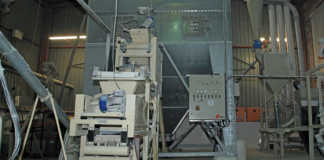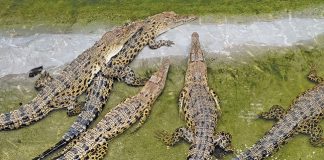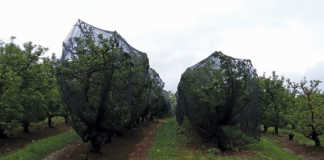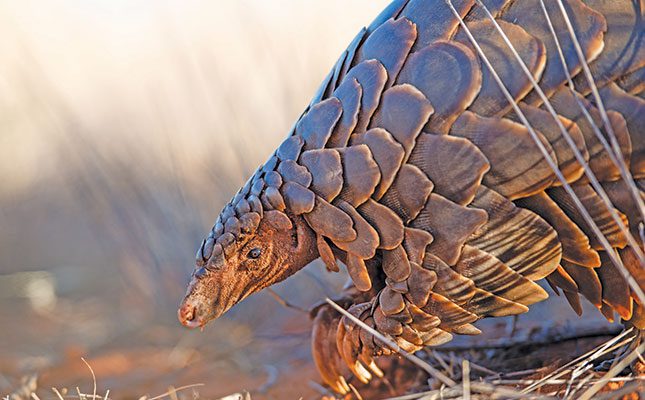
Photo: Mike Sutherland
According to the World Wildlife Fund (WWF), more than 1 million pangolins were trafficked over a 10-year period, with 2019 data indicating a pangolin is poached every three minutes.
In June 2020, China increased protection for the native Chinese pangolin (Manis pentadactyla) to the highest level, which closed an important loophole for consumption of the species in-country.
READ Captive breeding and wildlife trafficking
Additionally, the government will no longer allow the use of pangolin scales in traditional medicine, a big win given that an estimated 195 000 were trafficked in 2019 for their scales alone (Challender, et al, 2020).
Tswalu-based University of the Witwatersrand Master’s candidate Daniel Rossouw tells Farmer’s Weekly that the pangolin’s defence mechanism of rolling into a ball makes them easier to capture.
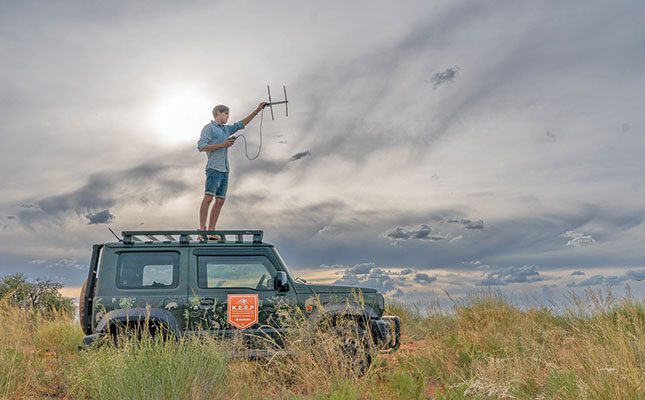
Locally, pangolin scales are used for charms and traditional medicine as well as bush meat, he says.
“The International Union for the Conservation of Nature (IUCN) has classified Temminck’s pangolins (Smutsia temminckii) as vulnerable due to their diminishing population, largely as a result of their exploitation in the illegal wildlife trade.
“However, this raises the question as to why we should care about the loss of pangolins. My study attempts to provide an answer to this question through quantifying the functional ecological role of Temminck’s pangolins in the Kalahari ecosystem.
In other words, I am trying to understand the ecosystem services that they provide, and in so doing, give further justification for the conservation and protection of pangolins.
“I am measuring aspects of pangolin foraging behaviour. I’ve started with a spatial aspect, looking at the distribution and frequency of pangolin foraging sites.
Next, at several dig/foraging sites, I’m determining soil turnover, by measuring the volume of soil removed during a dig.
I am also taking soil samples at some of the dig sites which I will use to compare nutrient concentration to that of a control sample taken nearby to the dig site.
“Soil turnover and nutrient cycling have been shown to be important ecosystem services. Lastly, any biodiversity (for example. insects, seeds, dung) accumulating in the dig sites is being recorded.”
For determining soil turnover
“At each dig site, the GPS location of the dig site is recorded, and the width and depth of the dig is measured.
Digs are lined with plastic wrap and filled with surrounding soil to determine soil volume turned over during digging activity. At some of the digs, core soil samples will be collected to determine soil density in a laboratory, which will then be converted to the mass of soil displaced at each dig.”
For quantifying nutrient cycling
“Soil samples are being taken from several foraging dig sites, as well as from one metre away as a control. These soil samples will be dried and sieved, and then their nitrogen and carbon content will be determined in the laboratory. The same sites are being returned to each season to assess the change in nutrient content over time.”
For biodiversity accumulation
“Several foraging sites have been marked and all biodiversity (insects, seeds, dung) accumulating in the dig sites are counted. The same sites will be returned to each season to assess the accumulation over time.”
Challenges
“The main challenge has been adjusting my sleep cycle to be more in line with that of the pangolins. Working alone, out in the field, on foot, at night-time, has also taken some getting used to.
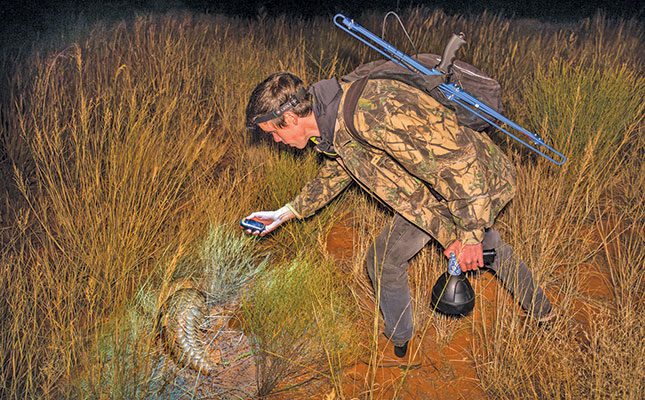
At first it is quite unsettling, however, soon enough you become accustomed to the sounds of the veld.
“With the assistance of staff and guides at Tswalu, we opportunistically locate pangolin individuals.
We currently have three pangolins tagged with VHF tracking transmitters (one female and two males) and are hoping to tag a further three. Hence, in total, we hope to have a sample size of six individuals.
The tag weighs 40g, less than 1% of the lower limit of pangolin body mass (6kg) for our study.
When a pangolin is found, its natural defence mechanism is to roll into a ball, also making it easy to tag.
READ Why aardvark numbers are dwindling in the Kalahari
The tags are attached by drilling a single hole into a scale at the base of the pangolin’s tail and attaching the tag with a single bolt, which is done without the need for anaesthetising the animal.
The tagging process takes no longer than 15 minutes, minimising the stress placed on the animal.
Our team has over eight years’ experience tagging pangolins, and we have not seen any consequences to the natural behaviour of the animals.
“A typical night in the field generally consists of heading out just prior to sunset. I’ll start by using the radio telemetry to track the pangolin individual to a specific burrow.
“More often than not several hours are spent waiting outside a burrow or napping in my vehicle before the individual leaves to forage. They can be quite variable in the times that they begin foraging. Once the individual is active, I’ll follow a few metres behind them, recording every time they forage.
Depending on the sampling that I require, I’ll mark sites to return to after my observational period is over, where I will then collect soil nutrient, soil turnover or biodiversity accumulation data. I will typically spend several hours in the field, often only returning home during the early hours of the morning.”
Each pangolin is tagged with a transmitter that transmits a specific frequency, hence when I track them, I know exactly which individual I’ll be working with.
If you spend enough time with different individuals you become familiar with their unique behaviours.
Some individuals keep a small home range and like reusing the same burrows, while others forage across larger areas and use a network of burrows.
Over time you get to know each individual, some have a more golden colouration or chipped scales (battle scars), and soon you get to know their individual behaviours.
“Foraging data collected will be analysed with respect to monthly pangolin prey abundance sampling.
By looking at how the ant and termite abundance, (the pugnacious and cocktail ants, and harvester termites) vary across the year, we can hopefully provide reasoning for any variations we may find in the foraging data.
“The pangolin project forms part of the broader Kalahari Endangered Ecosystem Project (KEEP).
One of the aims of KEEP is to identify how organisms in the Kalahari ecosystem are linked, and how the ecology of those organisms changes when their environment changes, and how that cascades through the ecosystem.
This is a particularly important question as we face the potential impacts that climate change may have on the Kalahari ecosystem.
My project will link climate, vegetation, insects and pangolins together, and attempt to show how they feed into the greater ecosystem where many other organisms depend on the same biotic and abiotic factors as pangolins.
Other teams working under the KEEP umbrella could ultimately link their respective species’ responses to the responses of pangolins through changes to lower trophic levels such as vegetation and insects.
Through my project, I will continue with the long-term monitoring of insects and vegetation.
Ultimately, we hope that studies like mine will contribute to better understanding the Kalahari ecosystem, its ecological balances and how climate change may affect these balances.
READ Ostriches prove their worth in harsh drought
“A previous study by Panaino, et al, 2022, has shown that pangolin activity, and by extension foraging behaviour, is in large part connected to prey abundance. I hope that by continuing the long-term insect sampling we may further understand any effects on pangolin foraging behaviour.”
Pangolin burrow usage
As for burrow usage, the pangolins generally use vacated aardvark or porcupine burrows.
This occasionally leads to interspecific interactions, however, research is yet to investigate any effects that these interactions may have on the pangolins.
“There is still limited literature on why pangolins move burrows or change the frequency at which they are using certain burrows. It is suspected that food availability, parasite load and predation threat may play a role. Hopefully, by spending more time with pangolins, I will be able to figure out if there are any trends.”
World Leader in research
The Tswalu Foundation stemmed from the vision that Jonathan and Jennifer Oppenheimer had to provide a means of both encouraging and facilitating environmental research at Tswalu Kalahari.
In 2009 this vision became a reality when the foundation was created with seed money from the family being used as initial capital to fund various research projects on Tswalu.
From its humble beginnings, the Tswalu Foundation has grown into a world leader in the field of environmental research within the southern Kalahari and attracts research teams from across the globe.
To generate income for research, a core objective of the foundation has always been to stimulate interest among Tswalu staff and guests through ongoing interaction with both researchers and foundation staff while visiting Tswalu.
Through the carefully selected research projects currently on the go at Tswalu Kalahari, the Tswalu Foundation continues to contribute in a meaningful way to the scientific and ecological management not only of this reserve but of communities both locally and internationally.
Visit tswalu.com.








